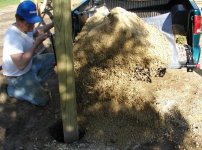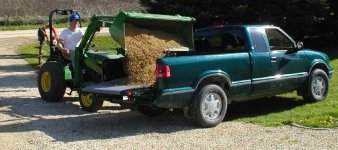Spencer
Veteran Member
- Joined
- Jan 2, 2002
- Messages
- 1,267
- Location
- Western Michigan
- Tractor
- NH TC33D w/R4 Tires, Rear Remote, Hydraulic Toplink, 2 Auxiliary Work Lights, 7308 Loader w/Kasco Uni-Hitch (Quick Tach)
<blockquote><font size=1>In reply to:</font><hr>
I gather that a lot of professional builders simply drop in a concrete "cookie" and plunk in the pole. And a lot of self-builders concrete them in to ground level, thinking they need the strength. The latter makes me wonder how long their poles will last being trapped in concrete all its life. I've seen what that does to wood.
<hr></blockquote>
Jim, can you or others please follow up on this. I have read previous threads on TBN saying that treated posts and concrete don't mix. I just received my building permit for my pole barn and plan on starting the project as soon as my wife finishes up her current two projects. I asked both our local building inspectors about the reaction between treated posts and concrete and they both laughed at the idea that the concrete might damage the posts. I will be required to place conrete cookies (at least 14" x 4") in the bottom of the holes for the posts to sit on. I am then required to pour concrete around the posts but it has not been made clear to me exactly how high I must go. My water table is quite high here and unless I get convincing evidence on why I shouldn't cover the posts in concrete I personally believe that I will be better off with concrete againts the posts instead of water.
I gather that a lot of professional builders simply drop in a concrete "cookie" and plunk in the pole. And a lot of self-builders concrete them in to ground level, thinking they need the strength. The latter makes me wonder how long their poles will last being trapped in concrete all its life. I've seen what that does to wood.
<hr></blockquote>
Jim, can you or others please follow up on this. I have read previous threads on TBN saying that treated posts and concrete don't mix. I just received my building permit for my pole barn and plan on starting the project as soon as my wife finishes up her current two projects. I asked both our local building inspectors about the reaction between treated posts and concrete and they both laughed at the idea that the concrete might damage the posts. I will be required to place conrete cookies (at least 14" x 4") in the bottom of the holes for the posts to sit on. I am then required to pour concrete around the posts but it has not been made clear to me exactly how high I must go. My water table is quite high here and unless I get convincing evidence on why I shouldn't cover the posts in concrete I personally believe that I will be better off with concrete againts the posts instead of water.


